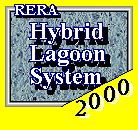
COPYRIGHTS
1999-2009 RERA
All right reserved.
Any Unauthorized
Copying
or Using Prohibited.
Preface
Table
of Contents
Foundation
Hybrid
Lagoon System
Case
Study
Applications
Proposals
3. Basic Construction of Facilities and Principle of Operation of the Activated Sludge Treatment Method (SBR Methods)
The non-continuous activated sludge method (hereafter, the SB activated sludge method) is a type of activated sludge method in which liquid waste is processed using a single basin (A). As a consequence, facility structures are simple and construction costs inexpensive; at the same time, this method boasts excellent operating characteristics, not possible with continuous treatment methods.

The operating characteristics of the SB activated sludge method are as follows.
Highly effective denitrification and dephosphorization functions.
Facilities are simple, with minimal costs for construction, repairs and maintenance.
Little energy is required for liquid waste processing, for cheap yet effective treatment.
No generation of excess sludge.
Maintains stable operation even during fluctuations of intake load.
Facility maintenance is simple, with no need for skilled personnel.
Only minimal use of dilution water, reagents and other materials.
In present-day Japan, the eutrophication of closed water systems such as Lake Biwa, Lake Suwa, Kasumigaura and other lakes, marshes and bays constitutes a large problem facing society. In light of this, the excellent denitrification and dephosphorization functions of the Low-Load Semi-Batch (LLSB) activated sludge treatment method are anticipated to grow in importance in future.